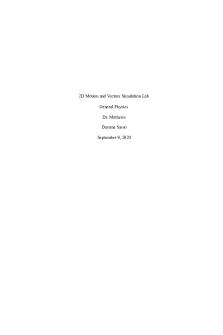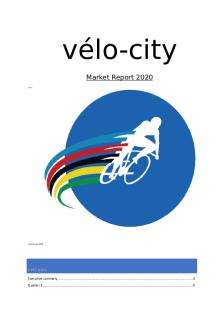Plaxis 2D Simulation Report PDF

| Title | Plaxis 2D Simulation Report |
|---|---|
| Author | Ahmed Khilji |
| Course | Soil Behaviour |
| Institution | University of Technology Sydney |
| Pages | 13 |
| File Size | 729.8 KB |
| File Type | |
| Total Downloads | 94 |
| Total Views | 169 |
Summary
PLAXIS 2D Simulation Option A...
Description
Soil Behaviour
PLAXIS 2D Simulation Research Report Tutor’s Name- Navid Yeganeh Student’s Name- Ahmed Khilji Student Number - 13525643
Soil Behaviour
Summary: The project was about a simulation performed on PLAXIS 2D software, and the aim of this assignment was to allow students to learn and use PLAXIS and understand soil mechanics. As Civil Engineers, it is important that safety is taken into consideration when forming a structure, and this is where PLAXIS 2D helps. For this task, the bearing Capacity was needed to be calculated from the output from PLAXIS. The materials properties required some research and at times patience was needed as a lot of things were unclear due to my lack of knowledge/skill in PLAXIS 2D. This report will go over some a brief explanation of the model, a step by step procedure of the way I was able to perform a simulation, results, and discussion about the problems I faced with this whole project. The report will also show a Load vs Settlement graph from which the Bearing Capacity when finally calculated as 2716.09 kPa after the 275kN was derived from the graph from the output given by PLAXIS. It worth mentioning that, some parts of the material properties were missing, and that research from reliable sources were needed.
3
Soil Behaviour
Table of Contents 1. Introduction…………………………………………………...………….……….1 2. Brief
Explanation
of
Model……………………………………………………....2 3. Modelling
Procedure
……………………………………...…...
……………......4 4. Results…………………………………………………………………………….8 5. Conclusion…………………………………………………………………...…...9 6. Problems Encountered……………………………………………………..…… 9 7. References…………………………………………………………………..….10
2
Soil Behaviour
1. Introduction Geotechnical engineering is a type of Civil engineering that is required for the process of building/constructing structures. It allows for the independent study of soil and construction materials as soil mechanics are very different in terms of its behaviour. As structures must be built in different environment and locations it's vital to understand the type of soil, we are using for the construction of the building. Plaxis 2D is a software that is very useful to simulate and give insight to civil engineers about the effects of their work on the soil. In our scenario, the structure is clay interfacing with a concrete pile and understanding how the soil would act. This report will also showcase the properties of the soils that very used simulate a structure and calculate its total bearing capacity, as well as a procedure on how the PLAXIS Simulation was completed and some further calculations.
1
Soil Behaviour
2. Brief Explanation of Model The PLAXIS 2D software was simple to use yet allowed us to fully understand the soil behaviour for our scenario and make further calculation much easily (Bearing Capacity). In order to achieve this a lot of research was done, to obtain values for the materials properties. The project properties were:
Material Properties:
2
Soil Behaviour
Drawing:
3
Soil Behaviour
3. Modelling Procedure Firstly, the project properties were needed to be inputted. The units were unchanged, and the contours were inputted from the values given to us. I choose the axisymmetry due to their being a rotational symmetry.
Next, was creating a borehole so that it defines the water table, as well as each of the soil layers, were given properties.
4
Soil Behaviour
Once the project properties, borehole and soil properties were set, I was then able to go on to the structures stage. There I created a soil rectangle and defined its position with:
I then assigned the material type to concrete. And then added an interface element with these positions:
Next step was to create displacement and modified in the selection explorer
Then I went on to Mesh Generation, by clicking Mesh on the top right of the screen, and click ‘Generate Mesh’,
5
Soil Behaviour
After viewing it in the output tab, we can now move on to the staged construction phase. Click the initial phase and change its calculation type to ‘K0 procedure’. We can now add another phase, and ID it as Concrete,
Then active the interface element and line displacement for the ‘concrete’ phase
6
Soil Behaviour
I then added a reference point, near the origin point. Then the final step was to calculate by pressing the button as shown below. Green ticks should appear next to the phases. I then clicked view calculation, and the output appeared.
From the output, I then checked the total displacement of the Concrete Phase, by switching at the red arrow and then viewing it from the deformation tab at the black arrow. (Click total displacement). Finally, I then clicked ‘Curves Manager’ at the blue arrow and set it to show, Uy (total displacement) and Fy (Load) to show the force on a graph, showing me the results.
Soil Behaviour
4. Results Bearing Capacity of a pile is the Maximum capacity it can take before the pile fails. For this to be calculated two lines were drawn to represent the elastic and inelastic region, giving us an intersection that gives us a rough estimate about the yielding point. The calculation is determined from the output when completed after relevant nodes were selected. The figure below shows the Fy vs Uy graph where Fy on the Y-axis shows the Load and the Uy on the x-axis show the Displacement. This output allowed to see the value 275 that was derived from the graph and was then used to calculate the Bearing Capacity. After further calculations the bearing capacity turned out to be 2716.09 kPa shown by the figures below.
8
Soil Behaviour
5. Conclusion Plaxis is a very powerful software that allows for the understanding of soil behaviour and allows for calculations to predict how soil would act. However, due to my lack of knowledge of this software, I feel unsatisfied on the amount of knowledge I have for Plaxis. Soil is really important in constructing structures as it can lead to failures that lead to harm, loss of money and importantly death. I was able to run calculations basic knowledge of this software, with aid from research and UTS Online. Although I was limited, I do believe that this software is very good in simulating soil mechanics important for civil engineering.
6. Problems encountered and recommendations My overall experience for this assignment was good as it was easy to understand, and instructions were very clear. Due to my limited knowledge, it was hard to follow through, but it wasn’t the instructions. I did not understand what each thing did and what was the point doing that. However, with aid from the internet, UTS online and friends I quickly learned some of the basics of the software. PLAXIS was also used/streamed from another PC meaning it was very laggy and slow. This made me a bit frustrated at times as my internet isn’t very fast. It might be my computer as well, however, the work was still achievable and worked fine most of the time. In the future, more lessons just dedicated to PLAXIS would be beneficial, as doing PLAXIS as the end of the class, is when usually students including me are trying to process information about Soil Behaviour Theory and it's harder to focus.
9
Soil Behaviour
7. References
MATHalino, Unit Weights and Densities of Soil, viewed 12th of October 2019,
Quora, What is the Poisson Ratio of Concrete, viewed 12th of October 2019,
The University of Texas, Some Real Numbers, viewed 12th of October 2019,
Jeff Hanson 2019, Solids: Lesson 8 - .2% Offset Method, Stress Strain Diagram, demonstration,
Youtube,
viewed
11th
October
2019,
10...
Similar Free PDFs

Plaxis 2D Simulation Report
- 13 Pages

Plaxis 2D report
- 10 Pages

PLAXIS 2D Tutorial Manual 2019
- 206 Pages

Simulation report
- 9 Pages

Simulation report
- 15 Pages

Final Report for Simulation
- 13 Pages

Bike Simulation Report (mkt
- 10 Pages

1 Ansys Fluent Simulation Report
- 9 Pages
Popular Institutions
- Tinajero National High School - Annex
- Politeknik Caltex Riau
- Yokohama City University
- SGT University
- University of Al-Qadisiyah
- Divine Word College of Vigan
- Techniek College Rotterdam
- Universidade de Santiago
- Universiti Teknologi MARA Cawangan Johor Kampus Pasir Gudang
- Poltekkes Kemenkes Yogyakarta
- Baguio City National High School
- Colegio san marcos
- preparatoria uno
- Centro de Bachillerato Tecnológico Industrial y de Servicios No. 107
- Dalian Maritime University
- Quang Trung Secondary School
- Colegio Tecnológico en Informática
- Corporación Regional de Educación Superior
- Grupo CEDVA
- Dar Al Uloom University
- Centro de Estudios Preuniversitarios de la Universidad Nacional de Ingeniería
- 上智大学
- Aakash International School, Nuna Majara
- San Felipe Neri Catholic School
- Kang Chiao International School - New Taipei City
- Misamis Occidental National High School
- Institución Educativa Escuela Normal Juan Ladrilleros
- Kolehiyo ng Pantukan
- Batanes State College
- Instituto Continental
- Sekolah Menengah Kejuruan Kesehatan Kaltara (Tarakan)
- Colegio de La Inmaculada Concepcion - Cebu







